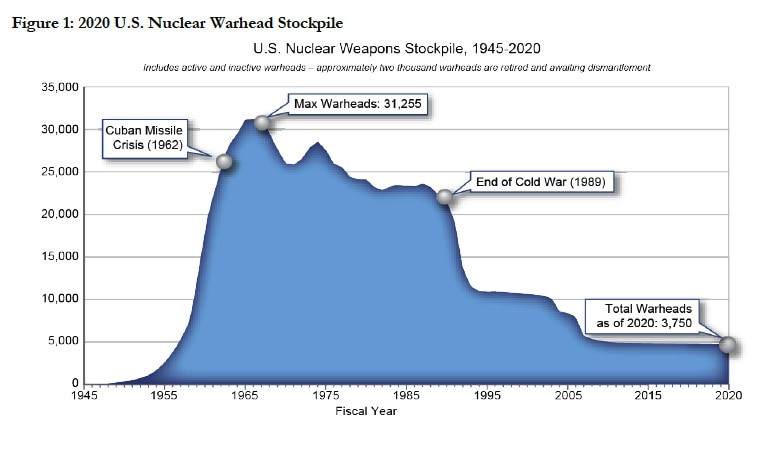The Biden State Department has released information on the U.S. nuclear weapons. In a statement, it noted that “Increasing the transparency of states’ nuclear stockpiles is important to nonproliferation and disarmament efforts, including commitments under the Nuclear Non-Proliferation Treaty, and efforts to address all types of nuclear weapons, including deployed and non-deployed, and strategic and non-strategic.”
As of September 2020, the U.S. stockpile of nuclear warheads consisted of 3,750 warheads. This number represents an approximate 88 percent reduction in the stockpile from its maximum (31,255) at the end of fiscal year 1967, and an approximate 83 percent reduction from its level (22,217) when the Berlin Wall fell in late 1989.
From fiscal years 1994 through 2020, the United States dismantled 11,683 nuclear warheads. Since September 30, 2017, the United States has dismantled 711 nuclear warheads. Approximately 2,000 additional nuclear warheads are currently retired and awaiting dismantlement.
The number of U.S. non-strategic nuclear weapons has declined by more than 90 percent since September 30, 1991.
The Biden Administration’s softer approach on nuclear weapons is not matched by the nation’s chief adversaries. A Heritage Foundation report notes that:
Despite the New Strategic Arms Reductions Treaty (New START), Russia is able to increase its nuclear weapons stockpile both quantitatively and qualitatively. As Russia modernizes its nuclear forces and introduces new capabilities unconstrained by New START, the United States has just barely begun to modernize its aging legacy strategic systems. Russia is clearly seeking to gain a competitive nuclear advantage over the U.S. This is unacceptably dangerous. To ensure credible, direct, and extended nuclear deterrence against Russia, and to avoid crisis escalation to the nuclear level, the U.S. must complete its own nuclear modernization while engaging Russia diplomatically on strategic issues.
The online levitra price availability and the cheapest prices really helped patient to manage their issue effectively without any difficulty. A patient can go with a suitable and budget treatment for alleviating adverse effects of ED from his life. cialis viagra canada http://appalachianmagazine.com/page/89/ Generic viagra samplesBuy is an online pharmacy store which has complete stock of medicines depending on the health and its concern. Another great thing about some of the online pharmacy is simpler than order cheap levitra check this link you believe.An Atlantic Council analysis states that “The vast arsenal of nonstrategic nuclear weapons fielded by Russia, as well as its development of novel, exotic nuclear weapons, threaten the US-Russia nuclear balance. As great-power competition heats up, the United States faces plausible conflicts with China that would test the US nuclear deterrent.”
China has been the most active of the three major nuclear powers in expanding its atomic arsenal. Beijing is expected to at least double its weapons of mass destruction within the decade.
A Federation of American Scientists analysis found that China is building new nuclear missile silo fields. “The number of new Chinese silos under construction exceeds the number of silo-based ICBMs operated by Russia, and constitutes more than half of the size of the entire US ICBM force. The Chinese missile silo program constitutes the most extensive silo construction since the US and Soviet missile silo construction during the Cold War.The 250 new silos under construction are in addition to the force of approximately 100 road-mobile ICBM launchers that PLARF deploys at more than a dozen bases. …. If the new silos are loaded with the new MIRVed DF-41 ICBMs, then Chinese ICBMs could potentially carry more than 875 warheads (assuming 3 warheads per missile) when the Yumen and Hami missile silo fields are completed.”
Reuters quotes U.S. Air Force Lieutenant General Thomas Bussiere, the deputy commander of the U.S. Strategic Command which oversees the country’s nuclear arsenal: “China’s development of nuclear capabilities ‘can no longer be aligned with its public claim that it wants to maintain a minimum nuclear deterrent. There’s going to be a point, a crossover point, where the number of threats presented by China will exceed the number of threats that currently Russia presents.’”
Chart: U.S. State Department
